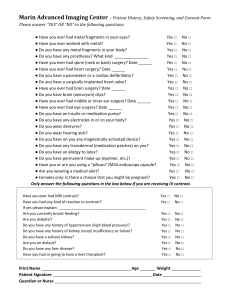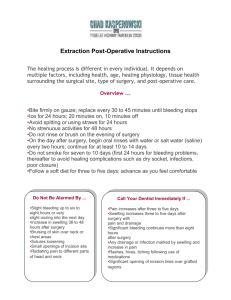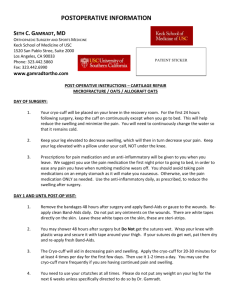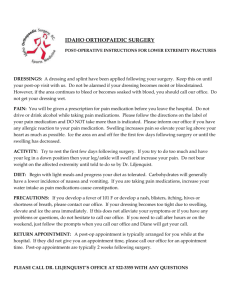discharge instructions following unicompartmental knee replacement
advertisement
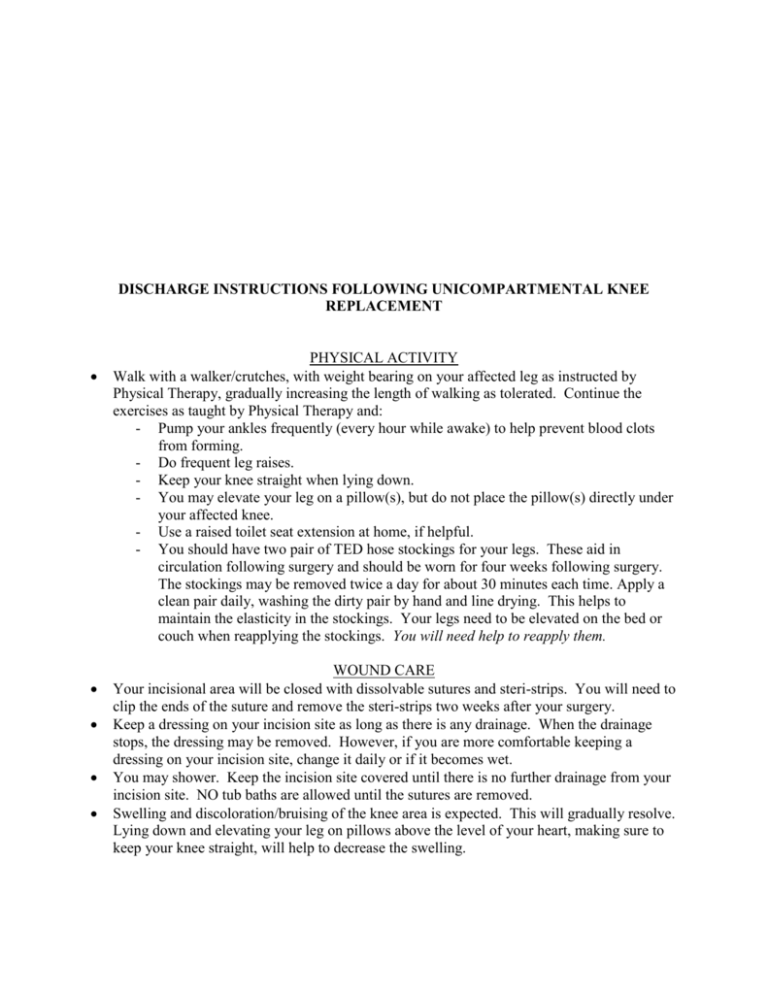
DISCHARGE INSTRUCTIONS FOLLOWING UNICOMPARTMENTAL KNEE REPLACEMENT PHYSICAL ACTIVITY Walk with a walker/crutches, with weight bearing on your affected leg as instructed by Physical Therapy, gradually increasing the length of walking as tolerated. Continue the exercises as taught by Physical Therapy and: - Pump your ankles frequently (every hour while awake) to help prevent blood clots from forming. - Do frequent leg raises. - Keep your knee straight when lying down. - You may elevate your leg on a pillow(s), but do not place the pillow(s) directly under your affected knee. - Use a raised toilet seat extension at home, if helpful. - You should have two pair of TED hose stockings for your legs. These aid in circulation following surgery and should be worn for four weeks following surgery. The stockings may be removed twice a day for about 30 minutes each time. Apply a clean pair daily, washing the dirty pair by hand and line drying. This helps to maintain the elasticity in the stockings. Your legs need to be elevated on the bed or couch when reapplying the stockings. You will need help to reapply them. WOUND CARE Your incisional area will be closed with dissolvable sutures and steri-strips. You will need to clip the ends of the suture and remove the steri-strips two weeks after your surgery. Keep a dressing on your incision site as long as there is any drainage. When the drainage stops, the dressing may be removed. However, if you are more comfortable keeping a dressing on your incision site, change it daily or if it becomes wet. You may shower. Keep the incision site covered until there is no further drainage from your incision site. NO tub baths are allowed until the sutures are removed. Swelling and discoloration/bruising of the knee area is expected. This will gradually resolve. Lying down and elevating your leg on pillows above the level of your heart, making sure to keep your knee straight, will help to decrease the swelling. 2 MEDICATIONS A prescription for pain medication will be given to you by your doctor prior to your discharge from the hospital. These medications are used to reduce your pain and must not be taken any more often than prescribed. In an effort to keep your pain under good control, you should take the pain medication routinely as prescribed during the first 24-48 hours following surgery. Then, as the pain lessens, begin taking it as needed (within the prescribed guidelines). As you become more comfortable, you may substitute Tylenol for pain control. Pain medication should be taken with food as this will help to prevent any stomach upset. Requests for pain medication should be made during normal office hours. Please Note: Pain medication will only be ordered during regular office hours. Do not drive while taking pain medications. Do not drink alcoholic beverages while taking pain medications. Ice may be used to your knee to help with swelling and pain relief. You will be on a blood thinning medication after surgery to help prevent blood clots from forming. We most commonly use Lovenox, an injectable medication. You will be taught to give yourself these injections while you are at the hospital beginning the day after surgery. The dosage is 30mg twice a day for eight days. (A total of sixteen doses). For those patients already on Coumadin, your prothrombin time will be closely monitored by your primary physician with weekly blood draws for the first month following surgery. After the first month, it is usually safe to resume your normal Coumadin routine. Take one Ferrous Sulfate 65 tablet two times a day for six weeks after surgery. You may use “over the counter” iron preparations. 3 You may resume your routine medications unless otherwise instructed. Often pain medication and inactivity cause constipation. Eat high fiber foods (fresh fruits, vegetables, bran) and increase your fluid intake if possible. Also, you may purchase Pericolace, a stool softener, at any pharmacy to aid in alleviating your constipation. Take this two times per day. DRIVING You most likely will be able to resume driving four weeks after surgery. Discuss this further with your doctor. OTHER INFORMATION Be aware that your joint may trigger metal detection devices. You will receive a card at your follow up visit that indicates that you have had a Total Joint Replacement. You may obtain a temporary handicap parking permit application from this office if you feel it is needed. FUTURE DENTAL OR SURGICAL PROCEDURES If you are going to have any dental work (including cleaning), any surgical or other invasive procedures done, notify your doctor/dentist that you have had a joint replacement. Your doctor/dentist will order an antibiotic for you prior to these procedures to prevent microorganisms from spreading to your new joint. IT IS IMPORTANT THAT YOU TAKE THESE PRECAUTIONS FOR YOUR WHOLE LIFE. Your Total Joint Replacement Card lists the procedures requiring pre-medication. PRECAUTIONS Notify the office if you: Develop new or more severe pain that cannot be controlled by the pain medication. Develop redness, swelling, drainage, or foul odor from your incision. Develop calf pain or tenderness. Have persistent numbness/tingling of the affected foot. Develop a temperature greater than 100.5 that is not associated with any other illness. It is not necessary to take your temperature every day. If you feel warm, take your temperature. Have any questions or problems. 4 DIET Following surgery, start by taking liquids such as water or carbonated soft drinks. If this does not upset your stomach, try soup and crackers. After this, you may resume your normal diet as tolerated. FOLLOW UP You should be seen in the office for staple removal with the Registered Nurse 10-14 days following your surgery. Call the office when you are discharged from the hospital to schedule this appointment. You will see your doctor approximately 4-6 weeks after surgery. 5 1/2009
